-
Astronomers, mathematicians, and naturalists spent three years learning the nation.
-
Napoleon’s invasion failed, nevertheless it led to some groundbreaking scientific work.
It has been a 12 months since Ridley Scott’s “Napoleon” debuted. It earned three Oscar nominations, together with for visible results and costumes. The movie had epic battles and sulky moments from Joaquin Phoenix, who portrayed the overall.
Nonetheless, the film did not cowl a lot about Napoleon Bonaparte’s curiosity in science, which had a profound impression on France’s mental pursuits following his reign.
When Napoleon invaded Egypt in July 1798, he introduced extra than simply tens of hundreds of troopers. He additionally recruited over 150 scientists, referred to as savants, to accompany him.
They arrived “with the purpose of each research and exploitation,” in accordance with one archaeologist.
Somewhat over a month later, on August 23, 1798, the scientific society known as the Institut d’Égypte, which nonetheless exists at this time, held its inaugural assembly in a lavish palace in Cairo and appointed Napoleon as its first vice chairman.
Napoleon needed to make use of the nation’s pure sources, historical past, and tradition for France’s profit. He urged the savants to deal with tasks like enhancing bread ovens, purifying the Nile’s water, and brewing beer with out hops.
The scientists’ duties have been made harder as a result of the ship carrying a lot of their surveying and scientific tools had sunk. Then, after a sequence of defeats in Egypt, Napoleon returned to France in 1799 and left most of the scientists stranded.
Regardless of setbacks, the engineers, mathematicians, naturalists, and others spent almost three years surveying, documenting, and gathering all the pieces from antiquities to mummified stays to animals largely unknown to the West.
Their work led to some novel discoveries, helped formalize sciences like archaeology, and spurred an infatuation with Egypt that is continued ever since.
1. The invention that chemical reactions are reversible

Graeco-Roman stays close to Wadi El Natrun, the realm the place Berthollet noticed natron.Werner Forman/Common Photos Group/Getty Photos
Earlier than chemist Claude-Louis Berthollet’s realization, the idea that chemical reactions might be reversible wasn’t universally accepted.
Nonetheless, Berthollet discovered sturdy proof to help the thought whereas learning the salt deposits within the lakes of the Natron Valley.
Natron, a naturally occurring salt, lined the limestone within the lakes. Historic Egyptians had used the substance to protect mummified our bodies as a result of it absorbed moisture and dissolved fats.
Berthollet noticed that the limestone, which contained calcium carbonate, chemically reacted with salt, aka sodium chloride, to provide natron, made from sodium carbonate.
In laboratory circumstances, chemists knew that the precise reverse response was doable, which led Berthollet to fairly conclude that chemical reactions have been reversible and that warmth and completely different quantities of a substance may decide which approach the response went.
2. A extra formal method to archaeology
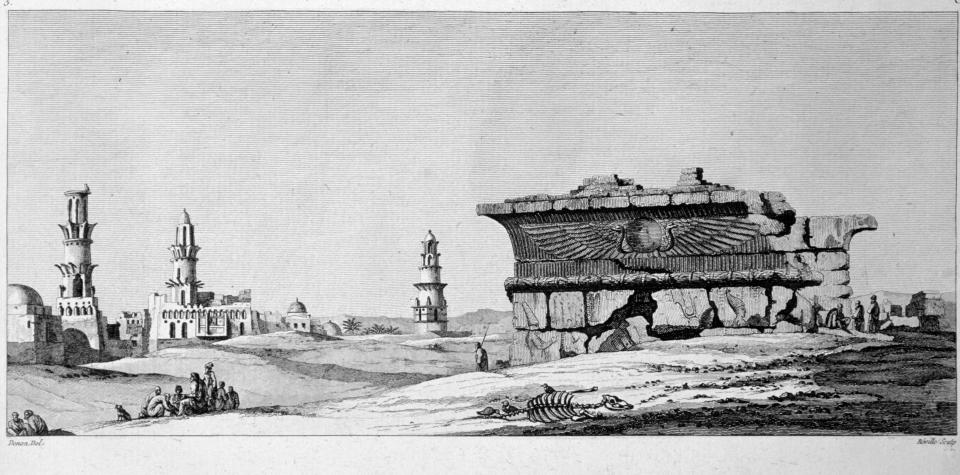
Denon’s drawing of the Edfu Temple. The folks give a way of the massive scale of the monuments.Artwork Media/Print Collector/Getty Photos
In Napoleon’s time, archaeology wasn’t but a formal science. Most savants had little expertise with artifacts. Sand nonetheless buried some temples that had but to be excavated.
Dominique-Vivant Denon, an artist and author, was awed by the traditional monuments he noticed. He went again to France with Napoleon and rapidly revealed a ebook together with his descriptions and drawings, “Travels in Higher and Decrease Egypt.”
On the time of Napoleon’s invasion, vacationers had lengthy identified of Alexandria, Cairo, and different elements of Decrease Egypt. The Nice Pyramids and Sphinx have been well-known. However Higher Egypt wasn’t as well-known.
That modified when the savants arrived. “The entire military, all of a sudden and with one accord, stood in amazement… and clapped their fingers with delight,” Denon later wrote.
His drawings and descriptions of the temples and ruins at Thebes, Esna, Edfu, and Karnak proved immensely widespread. Many have been depicted in modern work and impressed decor traits.
Since he’d needed to seize all the pieces in brief bursts of time, Denon had pushed for 2 commissions of savants to return and higher doc the monuments.
Napoleon’s architects and engineers made cautious drawings and took measurements of a lot of monuments. Others tried to measure the pyramids. (Napoleon by no means shot them with cannons, in case you have been questioning.)
3. Savigny created a brand new approach to classify bugs
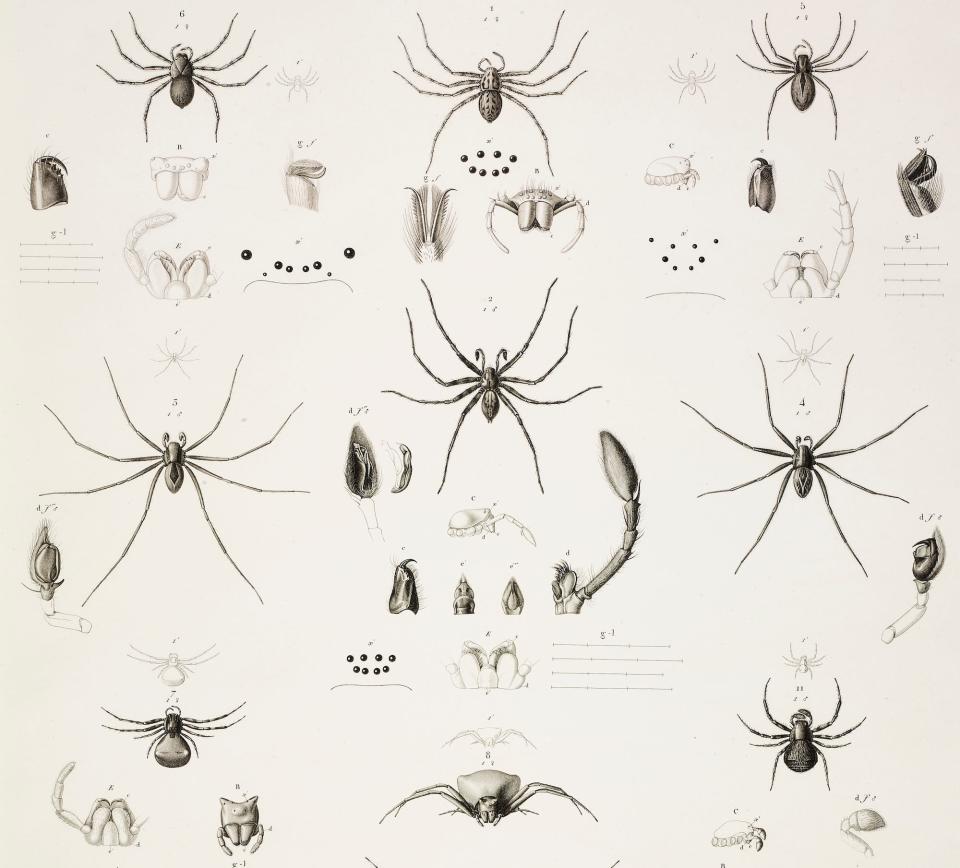
Savigny’s intricate drawings of arachnids from the from Description de l’Egypte.De Agostini Editorial through Getty Photos
Simply 21 and a botanist by coaching when he arrived in Egypt, Jules-César Savigny collected invertebrates like worms, bees, spiders, snails, and flies. He additionally took specimens of starfish, coral, and sea urchins.
When he was again in France, Savigny wanted to prepare the 1,500 species of bugs he’d introduced from Egypt. There did not but exist a scientific approach to distinguish one species of moth or butterfly from one other. So Savigny invented one.
Surprisingly, the bugs’ mouth elements had adequate variations to permit Savigny to separate them into species. He pored over the tiny jaws of the bugs. He drew over 1,000 photos of specimens, a few of which have been solely a centimeter lengthy.
Savigny utilized the identical rigor to arachnids, worms, and different animals that lacked backbones. A few of his classification strategies are nonetheless in use at this time.
4. The invention of a brand new species of crocodile that took 200 years to verify

Geoffroy’s depiction of the Nile crocodile (Crocodylus niloticus) from the Description de l’Egypte.De Agostini Editorial through Getty Photos
Etienne Geoffroy Saint-Hilaire was satisfied there have been two species of crocodiles within the Nile.
Like Savigny, Geoffroy was a prolific collector. Whereas in Egypt, he studied bats, mongooses, tortoises, and extra.
One purpose Geoffroy was capable of dissect and stuff so many specimens was he had bought an 11-year-old enslaved boy, whom he educated to assist together with his work.
Geoffroy carefully examined so many various sorts of animals that he began to see patterns between even very completely different species. It led to his idea of a “unity of plan” or “unity of composition” a form of quasi-evolutionary concept that Charles Darwin would reference a long time later.
Geoffroy’s theories usually irritated his fellow naturalists. That features when he tried to reveal a mummified crocodile he’d taken from Egypt represented a separate species.
Its jaw was utterly completely different from the Nile crocodile, Geoffroy mentioned. Plus, it was much less aggressive. One had even been on show in Paris. “It took pleasure in being patted; and anybody may, with out the least hazard, open its mouth, and place his hand between its tooth,” in accordance to at least one account.
His colleagues did not imagine him. Nonetheless, over 200 years later, biologist Evon Hekkala and a group of researchers analyzed the DNA of recent crocodiles and a few of Geoffroy’s mummies to verify his suspicions. Certainly, they confirmed two separate species swam within the Nile: Crocodylus niloticus and Crocodylus suchus.
5. The arrival of ophthalmology
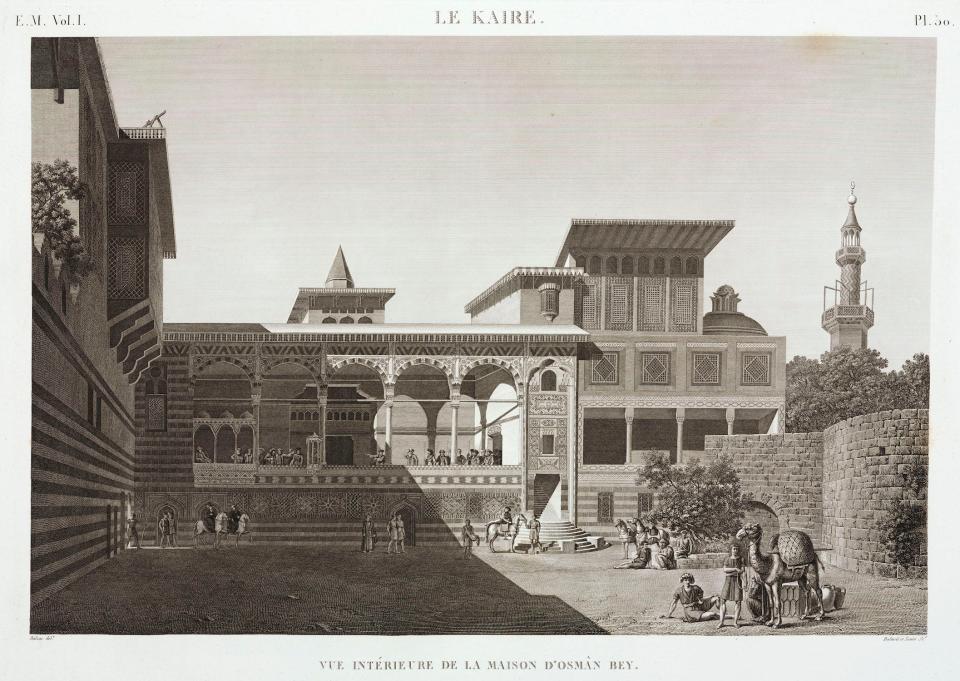
An engraving from the Description de l’Egypte displaying the inside courtyard of a home.Science & Society Image Library through Getty Photos
The French physicians who accompanied Napoleon encountered unfamiliar sicknesses in Egpyt. One illness that traveled with them again to Europe was one thing they known as Egyptian ophthalmia. Now referred to as trachoma, it might trigger itchy, swollen eyes and result in blindness.
It grew to become so prevalent that physicians throughout Europe began learning the illness. Geoffroy, who contracted it, was “completely blind” for weeks, he wrote.
As much as that time, ophthalmology wasn’t a formalized department of scientific analysis, however the race to search out the origin of this illness laid the groundwork for its creation.
Ultimately, British doctor John Vetch realized the pus from an contaminated eye may unfold the illness. Realizing it was contagious, Vetch developed strategies of prevention and remedy which can be thought of milestones within the historical past of ophthalmology.
6. The Rosetta Stone helped Champollion decipher hieroglyphs
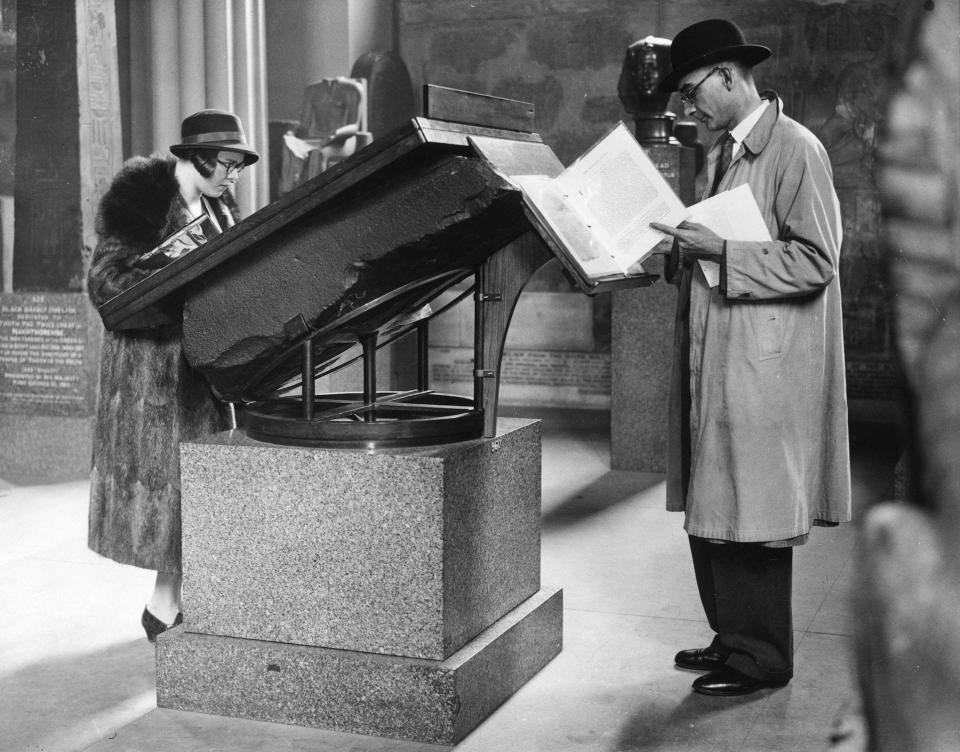
The Rosetta Stone is housed on the British Museum.Fox Pictures/Getty Photos
For hundreds of years, nobody may learn hieroglyphs, the pictorial writing that lined many Egyptian monuments.
When the French discovered the Rosetta Stone throughout their invasion, they knew it may function a form of translation key.
Deciphering hieroglyphs would enable students to learn the writing on scores of different Historic Egyptian texts and monuments.
In 1801, the British have been negotiating for France’s give up. One stipulation was that the British would take the antiquities and the savants’ collections, which included the Rosetta Stone.
Geoffroy advised the British that the savants would “destroy our property, we are going to disperse it within the Libyan sands, or we are going to throw it into the ocean” earlier than they handed it over. They have been allowed to maintain their notes and collections. However not the slab.
Three texts have been inscribed on the stone in Egyptian hieroglyphs, an Egyptian cursive script derived from hieroglyphs, and Historic Greek. Because the three have been an identical, the Greek writing may assist researchers decipher the hieroglyphs.
It took 20 years for French scholar Jean-François Champollion to translate them. Champollion made use of a copy the French savants had taken of the slab and revealed.
The Rosetta Stone is at the moment within the British Museum. Egypt has been attempting to get it again, calling it a “spoil of battle.”
7. The invention of an engraving machine that sped up the printing course of
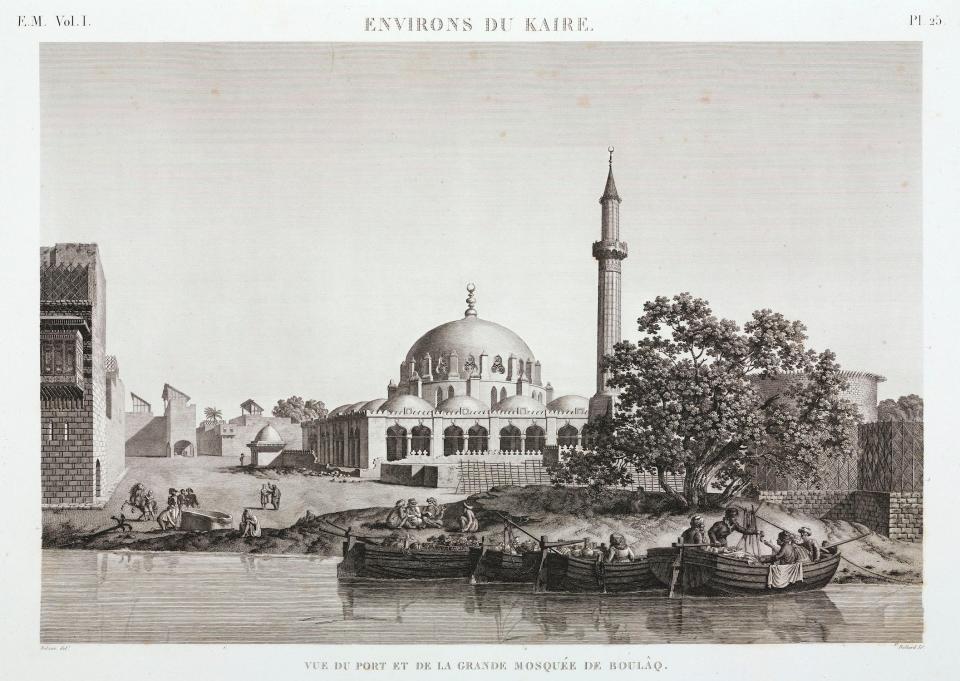
Simply one of many many detailed engravings added to the Description de l’Egypte, this certainly one of a mosque in Cairo.Science & Society Image Library through Getty Photos
When the savants returned to France, many labored on compiling the multi-volume ebook “Description de l’Égypte,” which amounted to 7,000 pages encompassing what they’d seen and studied in Egypt.
To save lots of a number of the laborious work of engraving, engineer Nicolas-Jacques Conté created a machine that automated a part of the method.
To print the a whole bunch of illustrations, engravers first needed to switch them to copper plates.
For plates with monuments, Conté’s machine may engrave the sky within the background. The engraver may program it to create clouds as properly.
What initially would’ve taken six to eight months might be accomplished in only a few days.
It was nonetheless an enormous enterprise and thought of to be probably the most formidable work of France within the early nineteenth Century. The primary quantity wasn’t printed till 1809. The ultimate quantity got here out within the late 1820s, almost a decade after Napoloen’s loss of life.
8. The science of geology flourished

Fossil shells discovered by François-Michel de Rozière from Description de l’Egypte.De Agostini Editorial/ICAS94/Contributor through Getty Photos
Many savants have been tasked with documenting the pure historical past of Egypt. Mining engineer François-Michel de Rozière had the troublesome job of describing the nation’s rocks and minerals.
A long time earlier than Napoleon’s invasion, many naturalists began adopting Carl Linnaeus’ two-word system for naming vegetation and animals. However rocks and minerals lacked an analogous broadly accepted language.
To precisely seize the nuances of the granite or shells he noticed, Rozière painstakingly described their textures, layers, and colours. One description referenced “clear quartz, yellowish feldspath, and black schist.”
He additionally understood the significance of together with illustrations of the rocks, which made them a lot simpler for different savants to determine. Within the Description de l’Egypte, his fifteen plates contained over 100 colourful illustrations of porphyry, basalt, and different rocks and fossils.
Although Napoleon did not use the geological data his savants gathered in Egypt, some argue that his invasion spurred the creation of army geology. Quickly, scientists have been surveying unfamiliar terrain throughout campaigns and utilizing their data for engineering tasks.
9. An try to date Egyptian antiquity

The Dendera zodiac is at the moment within the Louvre.JOSEPH EID/AFP through Getty Photos
Within the midst of his work on the Rosetta Stone, Champollion decried the elimination of one other piece of Historic Egyptian historical past from the nation.
Throughout a fast go to to the Dendera temple, Denon had sketched the ceiling, the place Historic Egyptians had carved zodiac indicators, Egyptian constellations, and different figures into the stone. Different engineers made extra detailed drawings of the intricate design.
In 1821, a French expedition dynamited a part of the temple and took the zodiac ceiling to France. Champollion anxious the elimination of the zodiac would result in the “full destruction” of the remainder of the ceiling and stripped the artifact of vital context.
French students debated whether or not they may use depicted options like eclipses thus far its creation. On the time, nobody knew precisely how far again in time human historical past stretched. Some estimated the zodiac was older than 5,000 years BCE. Others steered more moderen dates resembling 800 BCE. Champollion thought deciphering hieroglyphics would provide a extra dependable relationship methodology than an interpretation of the traditional sky.
More moderen relationship strategies put the Dendera zodiac at round 50 BCE, round Cleopatra’s period. One researcher known as it “the one full map that we now have of an historical sky” from that period. It stays within the Louvre Museum in Paris.
This story was initially revealed on December 2, 2023, and most not too long ago up to date on November 14, 2024.
Learn the unique article on Enterprise Insider
